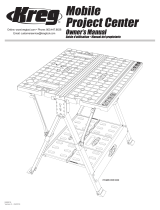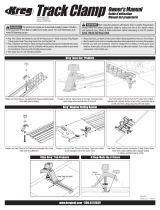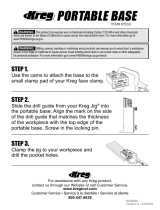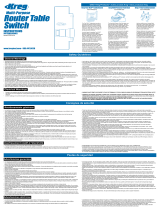Page is loading ...

ITEM# KCT
Logo on white, gray
or any lighter shade
when printing color
Logo on Pantone
2945 or any darker
shade when printing
color
Logo on white
or light shade when
printing grayscale
Logo on black or
dark shade when
printing grayscale
Owner’s Manual
Online: www.kregtool.com • Phone: 800.447.8638
Email: [email protected]
Items Included:
(A) Table base (1)
Tools Required:
Clamp Table
(I) Clamp Blocks (5)
(J) T-slot
bolts (5)
(K) Knurled Nuts (5)
(F) Table Top (1)
(H) Bench Clamps with Automaxx
™
(2)
(E) Short
Clamp Trak (1)
(A) Table Base (1)
(B) Truss-head bolts (40)
(G) Flathead wood screws (8)
(C) Hex Nuts (40)
(D) Long Clamp
Trak (1)

!
WARNING When using electric tools with this product, always follow the tool manufacturer’s instructions in addition to the safety precautions below to reduce
risk of re, electric shock, and personal injury. Read all these instructions before attempting to operate this product. SAVE THESE INSTRUCTIONS.
General Safety Instructions
1) Work area safety
a) Keep work area clean and well lit. Cluttered or dark areas invite accidents.
b) Don’t use power tools in a dangerous environment. Don’t use power tools in damp
or wet locations, or expose them to rain.
c) Do not operate power tools in explosive atmospheres, such as in the presence
of ammable liquids, gases or dust. Power tools create sparks that can ignite the
fumes or dust.
d) Keep children and bystanders away while operating a power tool. Distractions
can cause you to lose control.
e) Make your workshop child proof. Use padlocks, master switches, or remove starter keys.
2) Electrical safety
a) Ground electric tools. If the tool is equipped with a three-prong plug, it should
only be plugged into a grounded three-hole electrical outlet. If the proper outlet is
not available, have one installed by a qualied electrician. Never remove the third prong
or modify the provided plug in any way.
b) Do not expose power tools to rain or wet conditions. Water entering a power tool
will increase the risk of electric shock.
c) Do not abuse the cord. Never use the cord for carrying, pulling or unplugging the
power tool. Keep cord away from heat, oil, sharp edges or moving parts. Damaged or
entangled cords increase the risk of electric shock.
d) Use a proper extension cord and make sure it is in good condition. When using
an extension cord, be sure to use one heavy enough to carry the current your power
tool draws. An undersized cord causes a drop in line voltage resulting in loss of power
and overheating. Table 1 shows the correct cord gauge to use
depending on cord length and tool nameplate ampere rating. If in doubt, use the next
heavier gage. The smaller the gage number, the heavier the cord.
e) When operating electric tools, avoid body contact with grounded or earthed
surfaces such as pipes, radiators, kitchen ranges, and refrigerators. Contact with a
grounded surface increases the risk of electric shock.
3) Personal safety
a) Stay alert, watch what you are doing and use common sense when operating
a power tool. Do not use a power tool while you are tired or under the inuence of
drugs, alcohol or medication. A moment of inattention while operating power tools may
result in serious personal injury.
b) Always wear safety glasses. Everyday eyeglasses are not safety glasses. Safety
glasses have specially constructed lenses, frames, and side shields.
c) Use safety equipment. Use a face or dust mask when the cutting operation is dusty.
Safety equipment such as a dust mask, non-skid safety shoes, hard hat, or hearing
protection used for appropriate conditions reduces personal injuries.
d) Avoid accidental starting. Make sure the switch is in the off-position before
plugging in. Carrying power tools with your nger on the switch or plugging in power
tools that have the switch on invites accidents.
e) Remove any adjusting key or wrench before turning the power tool on. A wrench
or a key left attached to a rotating part of the power tool may result in personal injury.
f) Do not overreach. Keep proper footing and balance at all times. This enables
better control of the power tool in unexpected situations.
g) Secure workpieces. Use clamps or a vise to hold work when practical. This is safer
than using your hand and it frees both hands to operate the tool.
h) Never stand on the machine. Serious injury could occur if the tool tips or if the cutting
tool is unintentionally contacted.
i) Dress properly. Do not wear loose clothing or jewelry. Keep your hair, clothing
and gloves away from moving parts. Loose clothes, jewelry or long hair can be
caught in moving parts. Roll up long sleeves to the elbow. Wear protective hair covering
to contain long hair.
j) If devices are provided for the connection of dust extraction and collection
equipment, ensure these are connected and properly used. Use of these devices
can reduce dust-related hazards.
4) Power tool use and care
a) Keep guards in place and in working order.
b) Do not force the power tool. Use the correct power tool for your application. The
correct power tool will do the job better and safer at the rate for which it was designed.
c) Use the right tool. Don’t force a tool or attachment to do a job for which it was not
designed.
d) Do not use the power tool if the switch does not turn it on and off. Any power tool
that cannot be controlled with the switch is dangerous and must be repaired.
e) Disconnect the plug from the power source and/or the battery pack from the power
tool before making any adjustments, changing accessories, or storing power tools
Such preventive safety measures reduce the risk of starting the power tool accidentally.
f) Never leave a tool running unattended. Turn power off. Don’t leave the tool until it
comes to a complete stop.
g) Store idle power tools out of the reach of children and do not allow persons
unfamiliar with the power tool and these instructions to operate the power tool.
Power tools are dangerous in the hands of untrained users.
h) Maintain power tools. Check for misalignment or binding of moving parts,
broken parts, and any other condition that may affect power tool operation. If
damaged, have the power tool repaired before use. Many accidents are caused by
poorly maintained power tools.
i) Keep cutting tools sharp and clean. Properly maintained cutting tools with sharp
cutting edges are less likely to bind and are easier to control.
j) Use the recommended speed for the cutting tool or accessory and workpiece
material.
k) Only use parts and accessories recommended by the manufacturer. Consult the
owner’s manual for recommended accessories. Using improper accessories may cause
personal injury.
l) Use the power tool, accessories, and tool bits in accordance with these
instructions and in the manner intended for the particular type of power tool,
taking into account the working conditions and the work to be performed. Use of
the power tool for operations different from those intended could result in a hazardous
situation.
5) Service
a) Have your power tool serviced by a qualied repair person using only identical
replacement parts. This ensures that the safety of the power tool is maintained.
Guidelines for extension cord use
Extension cords are only to be used for temporary purposes. They do not replace the
need for installation of outlets and proper wiring where necessary.
In the shop and on construction sites:
1. Extension cords with an equipment grounding conductor must be used at all times.
2. Extension cords must be protected from damage, and not run through doorways
or windows where the doors or windows can close, causing damage to the cord.
3. Extension cords must be a minimum of 16 AWG and be rated for the equipment
in use.
4. Extension cords must be periodically inspected to ensure that the insulation and
conductivity of the wires are not compromised.
5. Extension cords should not be run through water or allowed to have connections
that may be exposed to accumulated water.
Always follow bit manufacturer’s speed recommendations. Some bit designs require
specic speeds for safety or performance.
Dust created by sanding, sawing, grinding, drilling, and other construction
activities may contain chemicals known to the State of California to cause cancer and
birth defects or other reproductive harm. Examples of these chemicals are:
a) Lead from lead-based paints
b) Crystalline silica from bricks and cement and other masonry products
c) Arsenic and chromium from chemically treated lumber
Your risk from exposure to these chemicals depends on how often you do this type of
work. To reduce your exposure, work in a well-ventilated area with approved safety
equipment, such as a dust mask specically designed to lter out microscopic particles.
'
16 16 16
16 16 NR
NR NR
NR NR NR NR
NR – Not Recommended
TABLE 1
!
WARNING:
!
This product can expose you to chemicals including Acrylonitrile
and other chemicals, which are known to the State of California to cause cancer and
reproductive harm. For more information go to www.P65Warnings.ca.gov.

Assembly
table base (A)
truss-head bolts (B)
nuts (C)
Clamp Trak (D)
Clamp Trak (E)
table top (F)
athead wood screws (G)
Less Pressure
More
Pressure
clamps (H)
INSTALL THE TRAKS
BENCH CLAMPS WITH AUTOMAXX™

Clamp Blocks (I)
T-slot bolt (J)
knurled nut (K)
Assembly
See the entire line of Clamp System Components at:
www.kregtool.com
Tabs
Tabs
CLAMP BLOCKS
Maintenance

ITEM# KCT
Logo on white, gray
or any lighter shade
when printing color
Logo on Pantone
2945 or any darker
shade when printing
color
Logo on white
or light shade when
printing grayscale
Logo on black or
dark shade when
printing grayscale
Guide d’utilisation
Online: www.kregtool.com • Phone: 800.447.8638
Email: [email protected]
Articles inclus :
(A) Base (1)
Outils nécessaires :
Clamp Table
(I) Blocs de serrage (5)
(J) Boulons
en T (5)
(K) Écrous moletés (5)
(F) Plateau (1)
(H) Serre-joints d’établi Bench
Clamp avec Automaxx (2)
(E) Rail court pour
serre-joint Trak (1)
(A) Base (1)
(B) Boulons à tête bombée de
1/4 po-20 x 1 1/4 po (40)
(G) Vis à bois à tête plate de
1 5/8 po (8)
(C) Écrous hexagonaux de
1/4 po-20 (40)
(D) Rail long pour
serre-joint Trak (1)

ARTÍCULO# KCT
Logo on white, gray
or any lighter shade
when printing color
Logo on Pantone
2945 or any darker
shade when printing
color
Logo on white
or light shade when
printing grayscale
Logo on black or
dark shade when
printing grayscale
Manual del propietario
Online: www.kregtool.com • Phone: 800.447.8638
Email: [email protected]
Artículos incluidos:
Herramientas necesarias:
Clamp Table
(I) Bloques de sujeción (5)
(J) Perno con
ranura en T (5)
(K) Tuercas moleteadas (5)
(F) Supercie de mesa (1)
(H) Abrazaderas para banco
con Automaxx™ (2)
(E) Clamp Trak
corta (1)
(A) Base de mesa (1)
(B) pernos de cabeza segmentada
de 1/4 pulg. y 20 x 1 1/4 pulg. (40)
(G) Tornillo para madera de cabeza
plana de 15/8 pulg. (8)
(C) tuercas hexagonales
de 1/4 pulg. (40)
(D) Clamp Trak
larga (1)
/









